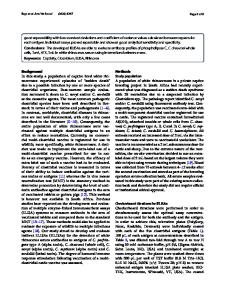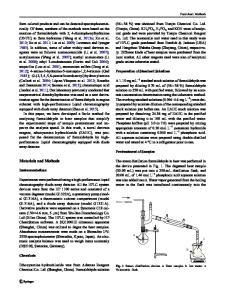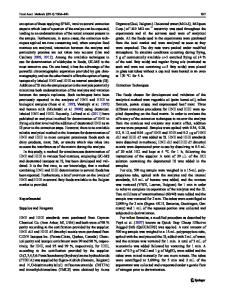Development and Evaluation of an Enzyme-Linked Immunosorbent Assay for the Determination of Thiacloprid in Agricultural
- PDF / 362,779 Bytes
- 7 Pages / 595.276 x 790.866 pts Page_size
- 99 Downloads / 335 Views
Development and Evaluation of an Enzyme-Linked Immunosorbent Assay for the Determination of Thiacloprid in Agricultural Samples Zhenjiang Liu & Ming Li & Haiyan Shi & Minghua Wang
Received: 27 March 2012 / Accepted: 21 June 2012 / Published online: 8 July 2012 # Springer Science+Business Media, LLC 2012
Abstract An enzyme-linked immunosorbent assay (ELISA) was developed based on a polyclonal antibody for the analysis of thiacloprid in agricultural samples. Thiacloprid hapten was synthesized and conjugated to bovine serum albumin to produce an immunogen and ovalbumin to produce a coating antigen. Polyclonal antibodies were obtained from immunized New Zealand white rabbits. Under optimal conditions (5 % methanol, 0.1 mol/L Na+, pH 5.5), the ELISA showed a 50 % inhibitory concentration (IC50) value of 0.01 mg/L and a limit of detection (IC10) of 0.47 μg/L. No obvious cross-reaction with the other structural analogs of neonicotinoid insecticides showed that the polyclonal antibodies had a high specificity for thiacloprid. The average recoveries from spiked water, soil, pear, and tomato were in the range of 80 to 119 %. The results of the ELISA were confirmed by high-performance liquid chromatography, and the correlation of the results from the two methods had a high correlation coefficient of 0.99 (n03) in spiked samples (soil, pear, and tomato). The proposed ELISA could successfully be applied to the determination of thiacloprid residues in agricultural samples. Keywords Thiacloprid hapten . Polyclonal antibody . Enzyme-linked immunosorbent assay . High-performance liquid chromatography . Agricultural sample Z. Liu : M. Li : H. Shi : M. Wang (*) Department of Pesticide Science, College of Plant Protection, Nanjing Agricultural University, Jiangsu Key Laboratory of Pesticide Science, Key Laboratory of Integrated Management of Crop Diseases and Pests, Ministry of Education, Nanjing 210095, China e-mail: [email protected]
Introduction Thiacloprid is a systemic and broad-spectrum neonicotinoid insecticide against not only sucking insects but also chewing insects and is the second member of Bayer's chloronicotintyl family (Jeschke et al. 2001; Elbert et al. 2001). Because thiacloprid has greater systemic activity, lower acute mammalian toxicity, and no cumulative long-term toxicity, it is widely used in many crops, such as rice, fruits, and vegetables (Liu et al. 2010). Thiacloprid has been attracting interest as a promising insecticide. Current analytical methods for the determination of thiacloprid residues are high-performance liquid chromatography (HPLC) (Yu et al. 2007; Wang et al. 2011; Seccia et al. 2008; Guzsvány et al. 2007; Wu et al. 2011; Mohan et al. 2010; Peña et al. 2011; Smodiš Škerl et al. 2009). Although these methods have low limits of detection and high precision and sensitivity, they are expensive and require specialized technicians and instrumentation. Therefore, there is growing demand for a simple, cost-effective, sensitive, and selective method for the analysis of thiacloprid residues. Enzyme-lin
Data Loading...











